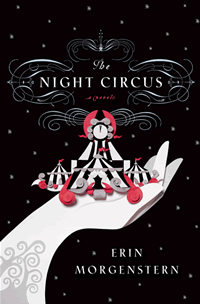Right Before Your Very Eyes
Erin Morgenstern’s debut novel, The Night Circus, is a spellbinding read
Erin Morgenstern, the debut author of one of this fall’s most anticipated novels, is drawing widespread comparisons to both J.K. Rowling and Stephanie Meyer. With The Night Circus, the thirty-three-year-old multimedia artist has not only crafted a story of epic proportions but also turned her own life into a fairy tale, replete with what looks to be a very happy ending.
The book was conceived almost exactly five years ago, when Morgenstern set out to write a book for National Novel Writing Month. (The annual NaNoWriMo challenge: to draft a 50,000-word novel in thirty days.) Having never written a book or published a word, Morgenstern thought it would be a good experiment, but she quickly faltered. “I got bored very fast with the story,” she has told interviewers, “and decided to send all the characters to the circus.”
The fantastical world she’s imagined is by turns playful, romantic, and terrifying, and the plot itself is spellbinding, including threads of Shakespeare’s Tempest and Romeo and Juliet. Published only a month ago, The Night Circus has already enticed legions of Harry Potter fans, and the film rights have been bought by Summit Entertainment, the producer of the Twilight movies. This book does share some elements with those two series: a protagonist who’s lost one or both parents, latent supernatural abilities, forbidden love, meddling grownups, subterfuge, and death-defying feats. Also, much of the action shakes down in the dark. But despite some similarities to its bestselling predecessors, The Night Circus stands in an arena all its own.
 In the book, which is set in 1873, a six-year-old girl named Celia is sent to London to live with her father, Hector, whom she’s never met. A magician with the stage name Prospero the Enchanter, Hector hadn’t known of the child’s existence: devoid of any particular loyalty or attachment to Celia, he wastes no time in teaching her magic and using her skills for his own self-centered gain. He challenges a rival conjurer, Alexander, to a contest that will determine which magician is the superior teacher. Hector swears that Celia can best any student Alexander trains, and Alexander feels the opposite.
In the book, which is set in 1873, a six-year-old girl named Celia is sent to London to live with her father, Hector, whom she’s never met. A magician with the stage name Prospero the Enchanter, Hector hadn’t known of the child’s existence: devoid of any particular loyalty or attachment to Celia, he wastes no time in teaching her magic and using her skills for his own self-centered gain. He challenges a rival conjurer, Alexander, to a contest that will determine which magician is the superior teacher. Hector swears that Celia can best any student Alexander trains, and Alexander feels the opposite.
It’s not clear, to readers or to the contenders, where, when, or how the competition will take place. “Let’s have no clauses at all beyond the basic rules of interference and see what happens,” Hector says. “I want to push the boundaries with this one. No time limits, either.” Hector and Alexander, it turns out, have been dueling like this for centuries, choosing unsuspecting protégés to learn magic, and then setting them to spar with each other until only one of them remains. The students have no choice; their mentors bind them to the competition so there’s no way out. Or, rather, there’s no way out alive.
The ensuing decade is devoted to contest preparation, in much the same spirit of trainers readying pups for dog-fighting. Hector slits Celia’s fingers and even breaks her bones to force her to learn to repair the injuries with her mind. As for his pawn, Alexander adopts an orphan named Marco and imposes a rigid study schedule. Neither Celia nor Marco has any idea what it is they’re being groomed for, or that, ultimately, their lives are at stake.
 In need of a venue for the contest, Hector and Alexander agree on a circus, though not just any circus will do. Hector enrolls a theater producer to develop “an immersive entertainment” that will “destroy the presumptions and preconceived notions of what a circus is and make it something else entirely.” The resulting black-and-white spectacle of Le Cirque des Rêves (the Circus of Dreams) is unlike anything in existence. Open from midnight to dawn, the traveling show includes an ice garden that bursts into bloom, an elaborate maze of clouds, acrobatic kittens, poems racing down the sides of trees, a ship of books on a sea of ink, mythical animals running around a carousel, and a mysterious contortionist who folds herself into a tiny glass box before disappearing in a puff of smoke. Celia performs nightly as the grand-scale illusionist, transporting the circus to each new venue without warning. Marco works behind the scenes, binding performers to the show (ensuring that they’ll never leave or grow older), and controlling a white bonfire that works as the circus’s engine.
In need of a venue for the contest, Hector and Alexander agree on a circus, though not just any circus will do. Hector enrolls a theater producer to develop “an immersive entertainment” that will “destroy the presumptions and preconceived notions of what a circus is and make it something else entirely.” The resulting black-and-white spectacle of Le Cirque des Rêves (the Circus of Dreams) is unlike anything in existence. Open from midnight to dawn, the traveling show includes an ice garden that bursts into bloom, an elaborate maze of clouds, acrobatic kittens, poems racing down the sides of trees, a ship of books on a sea of ink, mythical animals running around a carousel, and a mysterious contortionist who folds herself into a tiny glass box before disappearing in a puff of smoke. Celia performs nightly as the grand-scale illusionist, transporting the circus to each new venue without warning. Marco works behind the scenes, binding performers to the show (ensuring that they’ll never leave or grow older), and controlling a white bonfire that works as the circus’s engine.
The most compelling aspect of the action concerns the way the life-or-death rivalry between Celia and Marcos eventually gives way to love. Their overwhelming desire to be together, free from the competition to which they’re bound, fuels the book’s final half. A secondary storyline revolves around Bailey, a young farmer in Massachusetts, whose pure love of the circus leads him to play an instrumental role in its future. His enthusiasm for the nocturnal Big Top is shared with myriad “rêveurs,” who are captivated by the production: “They are enthusiasts, devotees. Addicts. Something about the circus stirs their souls, and they ache for it when it is absent.”
One might say the story appeals to certain readers in the same way. The Night Circus succeeds on a grand scale, despite many minor characters and spidery plotlines that can distract a reader from the main stage. The attraction between Celia and Marcos, and the unknown fate of the circus itself, create the tension of a high-wire act, and Morgenstern’s lush descriptions are magnetic, as if conjured by spell. The joy of reading this book is its offer of pure escapism. It’s written for adults, not children, but to be so wholly transported to this otherworldly place where visitors can, literally, go for a walk and get lost in the clouds—well, that’s pure magic.


